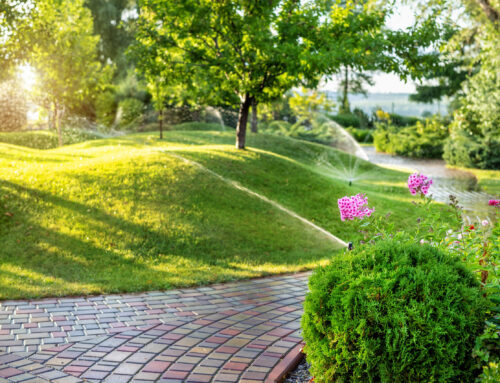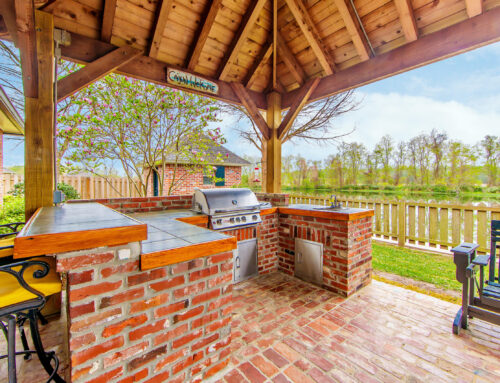Are you tired of the same old bushes and flowers in your yard? That’s why we introduced some landscaping ideas with natural rocks to incorporate into your landscape design.
Adding rocks to your landscaping can bring a whole new dimension to your outdoor space.
Rocks are a versatile and low-maintenance addition to any yard.
They come in all shapes, sizes, and colors, so you can choose the ones that best complement your home and garden.
In this blog post, we’ll give you some excellent ideas on how to incorporate rocks into your landscaping to give your yard the new look it deserves.
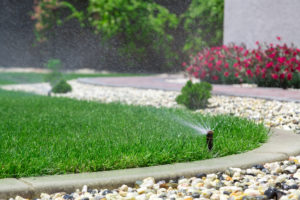
Highlight garden beds with rocks
Using natural rocks to highlight garden beds can add a level of depth to your garden designs.
Start by selecting rocks that are larger in size and have lighter hues. This will prevent your landscape from feeling dark and heavy. Vary the color and tone of the rocks to create contrast and visual interest.
Create borders around your garden beds by arranging the rocks along the edges to define the shape and outline of the beds. This will give a clear separation between your garden and other areas of your landscape.
Place large rocks along the sides of the pathway to create a defined border, then fill in with small stones. This will not only enhance the aesthetics but also guide visitors through your garden.
Construct rock walls around your garden beds to add height and structure. Stack rocks in a layered manner, gradually sloping them inward. This will create a raised bed effect and provide a visual focal point.
Instead of using traditional organic mulch, opt for rocks to cover the surface of your garden beds. This will help retain moisture, prevent weed growth, and add a decorative element to your garden.
Plant flowers or shrubs within the garden beds and strategically place rocks around them. This combination of rocks and plants creates a harmonious and visually appealing landscape.
This will help to keep the soil contained and prevent erosion in your flower beds.
Create a Zen-inspired natural rock garden
Begin by deciding the location and size of your rock garden. Consider the existing landscape and choose an area that receives the right amount of sunlight. Sketch out your design to visualize the placement of rocks, plants, and other elements.
Make sure you select rocks that have natural and organic shapes. Use a mix of sizes and textures to create visual interest. Smooth, rounded rocks can signify water, while jagged or vertical rocks can represent mountains.
Arrange the rocks in a balanced and harmonious manner. Use odd numbers of rocks (such as 3 or 5) and vary their sizes to create a sense of asymmetry, which is essential in Zen-inspired gardens.
Spread a layer of pea gravel or sand around and between the rocks. This will help create a clean and minimalist look reminiscent of traditional Japanese Zen gardens. Rake the gravel or sand in patterns to add depth and tranquility.
Choose plants that are low-maintenance and complement the Zen aesthetic. Opt for evergreens, ornamental grasses, and ground covers. Place them strategically around the rocks, leaving enough space for each plant to breathe.
Consider incorporating a small water feature, such as a mini pond or a trickling fountain. The sound of flowing water enhances the peaceful ambiance of a Zen garden.
Create pathways using stepping stones or gravel to guide visitors through your rock garden. These paths should be simple and straight, encouraging a slow and mindful walking experience.
Keep the design minimalistic and clutter-free. Avoid overcrowding the space with too many elements or bright colors. Embrace simplicity to foster a serene and calming atmosphere.
Remember, the key to creating a Zen-like atmosphere in your rock garden is to prioritize harmony, balance, and tranquility. Tailor the design to suit your personal preferences while staying true to the principles of Zen aesthetics.
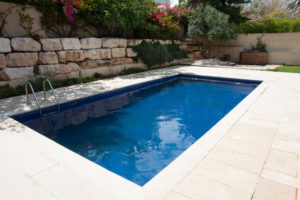
Build a retaining wall with natural rocks
Building a retaining wall with natural rocks can offer several benefits to improve the aesthetics of your landscape.
Natural rocks have a unique and timeless beauty of stone walls that enhances the overall aesthetics of your landscape. The varied colors, textures, and shapes of the rocks add visual interest and create a more organic and harmonious look.
Natural rocks provide versatility in design options. They can be stacked or arranged in various patterns and configurations to create a custom look that complements your landscape. The flexibility allows you to build a retaining wall that blends seamlessly with the rest of your outdoor space.
Rocks are known for their durability and longevity. When properly installed, a retaining wall built with natural rocks can withstand the test of time and weather conditions. This means you won’t have to worry about frequent repairs or replacements, resulting in cost savings in the long run.
Using natural rocks for your retaining wall aligns with sustainable landscaping practices. Unlike concrete or synthetic materials, rocks are a natural resource and do not require extensive manufacturing processes. By opting for natural rocks, you contribute to a more eco-friendly approach to landscaping.
Retaining walls help manage water runoff and prevent soil erosion. Natural rocks have excellent drainage properties, allowing water to flow through the cracks and crevices. This helps to mitigate water buildup behind the wall, reducing the risk of erosion and potential damage to your landscape.
A well-designed natural rock retaining wall can serve as a focal point in your landscape. It creates visual interest and draws attention to specific areas of your outdoor space. By strategically placing plants, shrubs, or decorative elements near the wall, you can further enhance their impact as a focal point.
An aesthetically pleasing landscape, including a well-built natural rock retaining wall, can significantly increase the value of your property. A visually appealing outdoor space is often seen as an attractive feature for potential buyers or guests.
When considering building a retaining wall with natural rocks, it is important to consult with a professional landscaper or contractor to ensure proper design, construction, and structural integrity.
Decorative rock features
Adding decorative rock features to your landscape designs offers several benefits.
Decorative rocks require minimal upkeep compared to other landscaping elements. They don’t need watering, pruning, or mowing, saving you time and effort. This makes them a practical choice for busy homeowners or those looking for low-maintenance landscaping solutions.
Decorative rocks can enhance the aesthetic appeal of your landscape. They come in various colors, shapes, and sizes, allowing you to create unique and eye-catching designs. Whether using large boulders as accent pieces, lava rocks as ground cover, or in rock gardens, natural rocks can add texture, contrast, and visual interest to your outdoor space.
Rocks can act as a natural weed barrier when properly installed. By covering the soil surface with decorative rocks, you can suppress weed growth, reducing the need for herbicides or constant weeding. This not only saves time but also helps maintain a cleaner and more polished appearance.
Decorative rocks can help prevent soil erosion in your landscape. Placing rocks strategically on slopes or areas prone to erosion can stabilize the soil and slow down water runoff. This protects your plants, prevents soil loss, and maintains the integrity of your landscape.
Rocks are permeable and allow water to penetrate the soil slowly, promoting better water absorption and reducing water runoff. By incorporating decorative rocks into your landscape, you can improve water efficiency and conserve resources. This is particularly beneficial in arid regions or during drought conditions.
Decorative rocks are versatile and can be used in various ways. They can be arranged to create pathways, borders, or focal points. Rocks can also be combined with other landscaping elements such as plants, mulch, or water features to achieve a cohesive and visually appealing design.
When planning to incorporate decorative rocks into your landscape, consider consulting with a professional landscaper or designer to ensure proper placement and selection of rocks that complement your overall design vision.
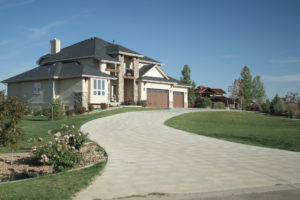
Edge your driveway with river rocks
Edging your driveway with river rocks can add a touch of natural beauty and functionality to your landscape.
River rocks have a smooth, polished appearance that adds a charming and decorative element to your driveway. The different colors and sizes of the rocks create an organic and visually appealing border that enhances the overall aesthetics of your property.
By using river rocks as an edging material, you create a seamless transition between your driveway and the surrounding landscape. The soft curves and natural textures of the rocks blend well with plants, grass, or other hardscape features, creating a cohesive and inviting look.
River rocks provide a barrier against weed growth along the edges of your driveway. The rocks act as a physical deterrent, preventing weeds from spreading into the paved areas. This can save you time and effort in weed maintenance, keeping your driveway neat and tidy.
River rocks are known for their durability and ability to withstand outdoor conditions. They can endure heavy use, resist erosion, and maintain their appearance over time. This makes them a long-lasting choice for driveway edging, reducing the need for frequent replacements or repairs.
River rocks can assist in improving water drainage along your driveway. When properly installed, they allow rainwater to flow freely, preventing puddles or water buildup. This can help keep your driveway dry and reduce the risk of damage caused by standing water.
Using river rocks for driveway edging requires minimal maintenance. Unlike traditional edging materials like wood or concrete, river rocks do not require staining, sealing, or regular upkeep. Simply occasional cleaning to remove debris or dirt is usually sufficient to keep them looking their best.
When implementing river rocks as driveway edging, it’s important to prepare the foundation properly and ensure the secure placement of the rocks. Consider consulting with a professional landscaper or contractor to ensure the best results.
In conclusion
Incorporating natural rocks into your landscaping project can be a fun and creative way to transform your yard.
From using them to highlight garden beds and building retaining walls to creating beautiful rock gardens and decorative rock features, there are so many ways to use rocks to add interest and texture to your outdoor space.
Choose the rocks that best complement your home and garden, and have fun creating a new and improved outdoor space that you’ll love spending time in.
Contact Bayside Landscaping today to get started!!!

